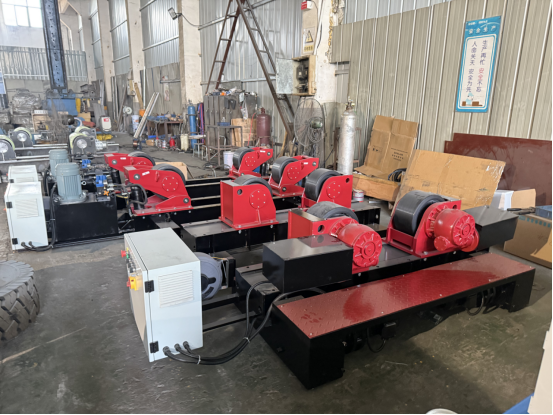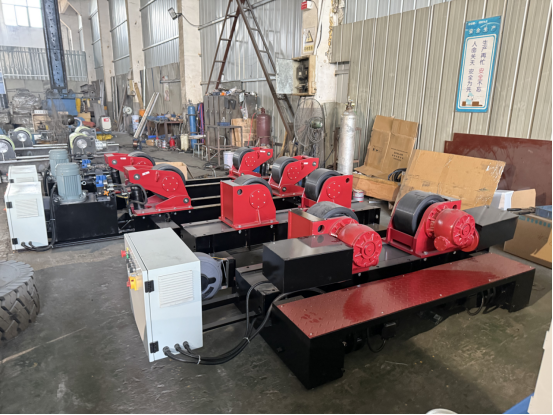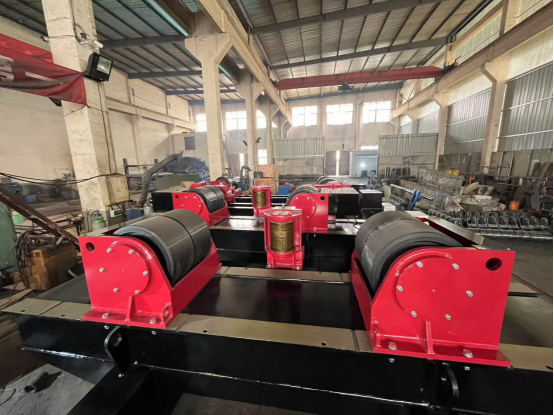In the wind power equipment manufacturing workshop, Engineer Li Ming was frowning at an inspection report—a 30-meter-long wind tower section showed significant bending after welding, with straightness deviation exceeding the allowable limit by 2.5 millimeters. “This is already the third quality incident this month,” he said helplessly. “Traditional fixed roller racks simply cannot support the dynamic welding process of oversized workpieces.”
This scenario plays out daily in the heavy manufacturing sector. As products in wind power, shipbuilding, and other industries trend toward larger sizes, “welding deformation of long workpieces” has become the primary bottleneck restricting product quality and production efficiency.
Growing Line Rotator: Redefining Welding Standards for Extra-Long Workpieces
L'émergence de la growing line rotator provides a revolutionary solution to this industry challenge. This innovative equipment adopts a modular design concept, using multiple self-propelled roller units to provide dynamic support as the workpiece length continuously increases.
Compared with traditional equipment, the core advantages of intelligent growing line rotators are reflected in three aspects: the synchronization control system ensures consistent speed across all units, preventing workpiece distortion; the hydraulic lifting system adjusts support height in real time to compensate for welding deformation; wireless linkage functionality eliminates cumbersome wiring, significantly improving production line layout flexibility.


Technological Breakthrough: From Passive Support to Active Adaptation
At a wind tower manufacturing base in Jiangsu, an intelligent growing line rotator system is operating smoothly. Twelve self-propelled roller units work in coordination under the control of a central PLC, supporting a 4.5-meter diameter, 36-meter-long tower section for 360-degree rotational welding.
“The ingenuity of this system lies in its adaptive capability,” explained the on-site technical manager. “Using laser distance sensors to monitor the workpiece posture in real time, the system automatically adjusts the height and pressure distribution of each support point, controlling welding deformation within 0.5 millimeters.”
Actual measurement data shows that after adopting intelligent growing line rotators, the first-pass qualification rate for wind tower welding increased from 82% to 98.7%, the production cycle per unit shortened by 40%, and reducing rework alone saves over 2 million yuan annually.
Industry Applications: Comprehensive Innovation from Wind Power to Shipbuilding
La valeur d'application de la technologie intelligente growing line rotators has been verified across multiple heavy manufacturing sectors. In offshore wind power, it solves the support challenges for welding extra-long tower sections; in shipbuilding, it provides precise positioning solutions for hull circular segment welding; in chemical equipment, the alignment accuracy of pressure vessel cylinders has significantly improved.
Un directeur de production d'un groupe de fabrication d'équipements lourds a déclaré : "Nous avons déployé des growing line rotator systems on three production lines successively. Not only has product quality stability greatly improved, but we’ve also achieved mixed production of multi-specification products, increasing equipment utilization by over 50%.”
Guide de sélection : Comment évaluer des produits intelligents Growing Line Rotators
For companies considering equipment upgrades, evaluation is recommended from three dimensions: first, examine the system’s synchronization control accuracy, which directly relates to welding quality; second, focus on the equipment’s degree of modularization, which determines its ability to adapt to different working conditions; finally, verify the intelligence level of the control system, including functions like data collection, process optimization, and fault diagnosis.
Equipment safety performance should not be overlooked. High-quality intelligent growing line rotators should possess multiple safety mechanisms such as overload protection, emergency braking, and displacement monitoring to ensure fail-safe processing of large workpieces.

Perspectives d'avenir : Orientations du développement de l'amélioration intelligente
Avec l'approfondissement de l'application des technologies de l'industrie 4.0, l'intelligence... growing line rotators are developing toward higher levels of intelligence. Digital twin technology enables real-time monitoring of equipment status and predictive maintenance; artificial intelligence algorithms can automatically optimize welding process parameters based on historical data; the application of 5G technology will further enhance the response speed and stability of multi-equipment coordination.
Ces innovations technologiques ne favoriseront pas seulement l'amélioration des performances des équipements individuels, mais faciliteront également la transformation intelligente de systèmes de production entiers, apportant ainsi un soutien solide au développement de haute qualité de l'industrie lourde.
Conclusion : Le choix inévitable d'investir dans la fabrication intelligente
Under the background of manufacturing transformation and upgrading, adopting intelligent growing line rotators is no longer simply equipment updating but an important strategic choice for enterprises to enhance core competitiveness and achieve sustainable development. For companies still struggling with long workpiece welding quality, now is the perfect time to embrace technological innovation and move toward smart manufacturing.
